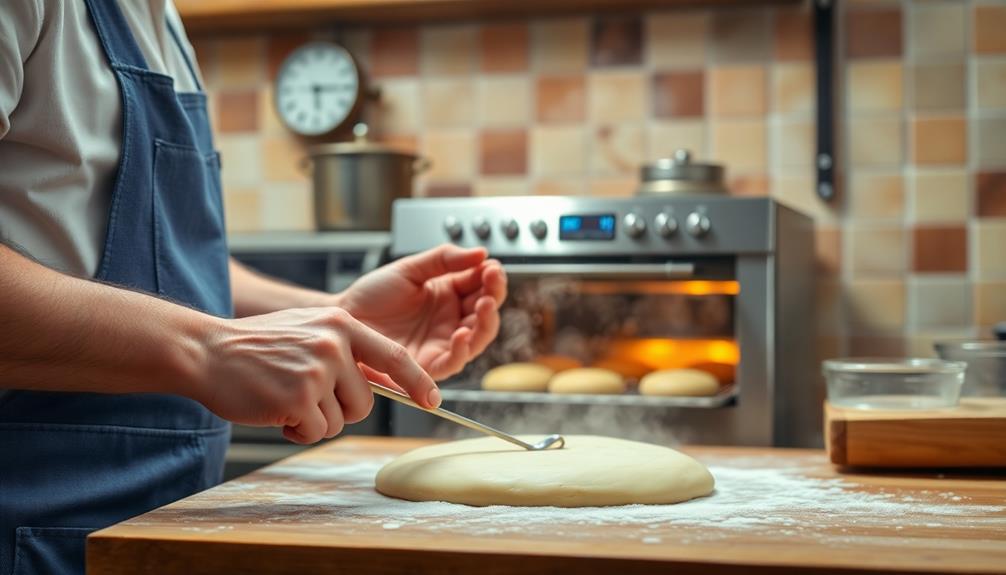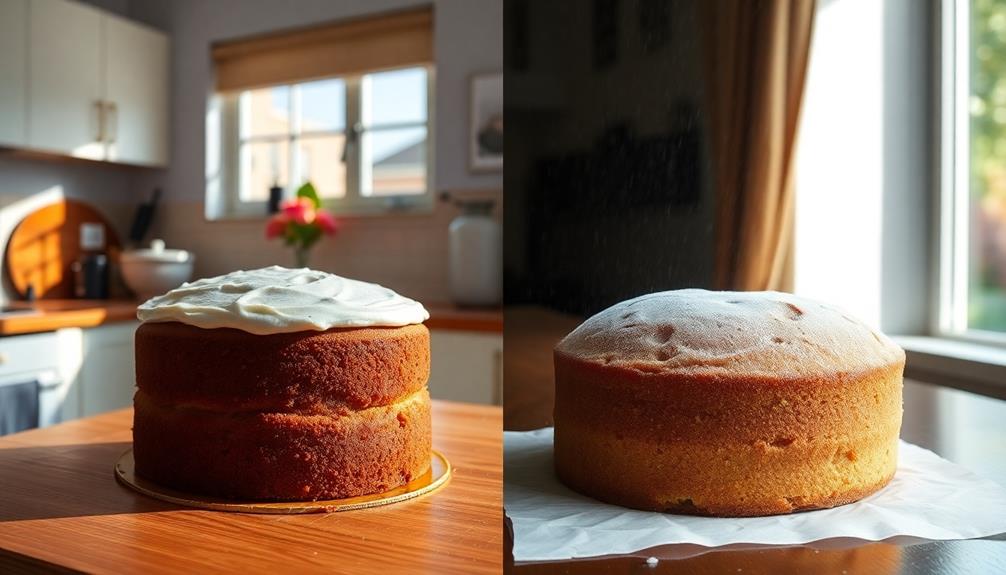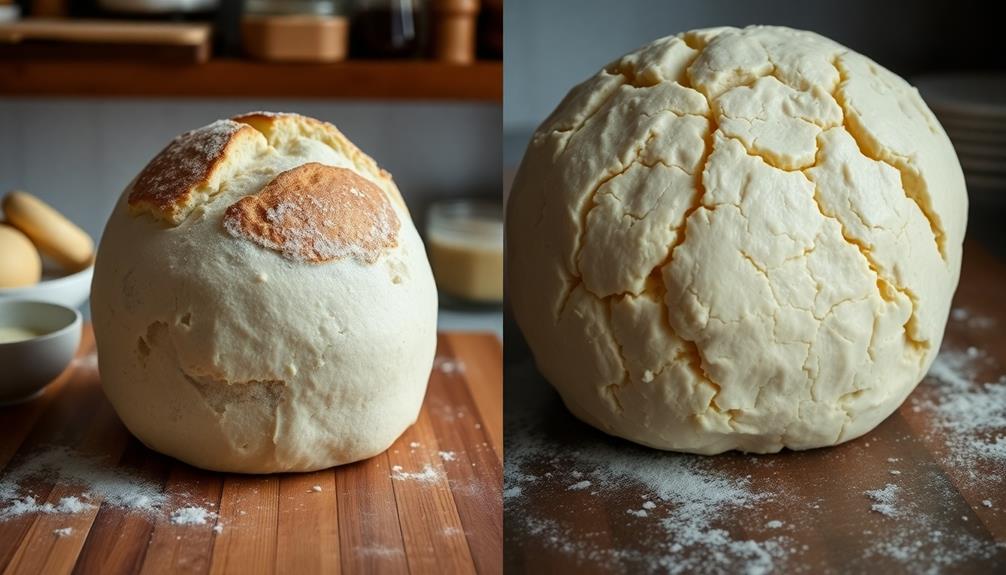Humidity can surprise you in the kitchen. It affects the weight and moisture content of your ingredients. On humid days, flour can absorb extra moisture, leading to clumping and inconsistent measurements. This can make your cakes denser and impact yeast activation, compromising rise. If it's particularly humid, you might need to cut back on liquid by a quarter cup and bake a bit longer. Proper storage in airtight containers is key to maintaining ingredient quality. Adjusting your techniques based on humidity can transform your baking experience—keep exploring to discover more ways to enhance your results!
Key Takeaways
- High humidity can cause flour and sugar to clump together, leading to inaccurate measurements and inconsistent baking results.
- Excess moisture in the air can make dough sticky, affecting its handling and rising ability during the baking process.
- Ingredients like brown sugar become overly sticky in humid conditions, complicating their use in recipes.
- Baking times may need to be extended on humid days due to increased moisture in the air affecting cooking rates.
- Humidity can destabilize meringues and whipped egg whites, making them less reliable for light and airy baked goods.
Understanding Humidity in Baking

Humidity plays an essential role in baking, affecting how your ingredients perform and ultimately the quality of your baked goods. When humidity levels are high, moisture saturates the air, which can greatly influence hygroscopic ingredients like flour and sugar. These ingredients tend to absorb excess moisture, leading to clumping and disrupting the chemical reactions necessary for successful baking.
Additionally, humidity can impact the texture and flavor of baked goods, similar to how it influences the consistency of traditional dishes like Caldeirada, which rely on specific moisture levels for ideal flavor integration.
On days with humidity levels above 60%, you might notice your baked goods turn out denser, or worse, they could fall flat. That's because high humidity interferes with yeast activation, which thrives in at least 75% humidity for ideal dough fermentation.
Conversely, baking on drier days often yields better results, as your ingredients perform more reliably without excessive moisture.
Understanding local humidity conditions is crucial for any baker. By keeping an eye on humidity levels, you can adjust your techniques accordingly—whether it's altering ingredient measurements or modifying baking times.
When you grasp how humidity affects your ingredients, you'll be better equipped to create delicious, consistent baked goods, regardless of the weather outside.
How Humidity Affects Ingredients

Humidity plays a big role in how your ingredients behave in the kitchen. When moisture levels rise, dry ingredients like flour and sugar can absorb excess water, leading to clumping and altered textures.
This can be particularly problematic when baking delicate items like cakes or pastries, where precision is key. For instance, using ingredients that are too moist can lead to a denser texture, much like how the rich flavor of Red-Braised Pork Belly is achieved through careful cooking methods.
To maintain consistent results, you'll want to store your ingredients properly in airtight containers.
Ingredient Moisture Absorption
Baking ingredients can behave unpredictably when exposed to varying humidity levels. High humidity can cause dry ingredients like flour and sugar to absorb excess moisture from the air, leading to clumping and altered consistency in your recipes. For instance, one pound of flour may weigh more in humid conditions, affecting both weight and volume measurements. This can throw off your baking and lead to disappointing results.
In addition, the quality of fresh ingredients used in recipes, such as those found in Nettle and Potato Soup, may also be impacted by humidity, affecting their flavor and texture.
Brown sugar is another ingredient that changes with humidity. In dry conditions, it hardens, making it difficult to measure accurately. Conversely, in high humidity, it becomes sticky and challenging to work with.
Even salt isn't immune; its weight can fluctuate based on moisture content, with a teaspoon weighing anywhere from 5.3g to 6.6g. This variance can impact recipes that require precise measurements.
To mitigate these issues, proper storage in airtight containers is essential. This helps prevent ingredient moisture absorption, ensuring your baking maintains the desired texture and quality.
Storage Conditions Impact
When it comes to storing your baking ingredients, how you set things up can make all the difference. High humidity levels can wreak havoc on your dry ingredients. Flour and sugar can clump together due to moisture absorption, which can seriously impact your recipes.
For instance, the delicate balance of ingredients in traditional stuffed pasta can be similarly affected by humidity. To prevent this, always store these ingredients in airtight containers. This simple step helps keep excess moisture at bay and maintains the integrity of your baking supplies.
In humid conditions, brown sugar can harden if not stored properly. To soften it, just wrap it in a damp paper towel for a bit. Remember that salt isn't immune to humidity either; its weight can vary considerably, so precise measurements are vital for accurate baking results.
Storing your baking ingredients in cool, dry places is important. This practice not only keeps them fresh but also reduces the risk of moisture-related issues during baking.
Adjusting Recipes for Humidity

On particularly humid days, adjusting your recipes can make all the difference in achieving the perfect texture and flavor. For instance, when preparing dishes like Yekolo that rely on precise ingredient ratios, it's wise to reduce the liquid content in your recipes by about 1/4 cup. This helps compensate for the extra moisture your dry ingredients absorb.
Flour can clump and take in more moisture, so using a weighing scale for precise measurements is key to maintaining accuracy.
You might also need to tweak your baking times. Baked goods can take longer to cook in humid conditions due to the increased moisture. If your recipe calls for whipped egg whites or meringues, it's best to avoid baking on humid days, as the added moisture can prevent proper whipping and stabilization.
To combat humidity in your kitchen, consider using a dehumidifier. This can help create a more stable environment, allowing for consistent baking results regardless of the weather.
Impact of Temperature on Baking

Understanding temperature's role in baking is imperative for achieving the perfect result. When you use cold ingredients like butter and eggs, you risk creating dense cakes with poor crumb structure. This happens because the cold temperatures hinder proper creaming and emulsification during mixing.
Ideally, keep your baking ingredients at room temperature between 68°F and 72°F. If the temperature exceeds 80°F, butter can liquefy, leading to a loose batter that negatively impacts texture. For those who enjoy cooking, incorporating dishes like Mushroom Masala can showcase how the right temperature influences flavor development.
Warm temperatures are essential for yeast activation and dough rising. For proofing, aim for temperatures between 95°F and 110°F, especially in high humidity conditions of 80-85%. This warmth encourages yeast to do its job effectively.
However, excessive heat during baking can soften the butter too much, which limits steam production and affects the flakiness of pastries.
Accurate room temperature is critical for achieving the desired batter consistency. Any significant deviations can alter your final product's quality dramatically.
Effects of Air Pressure on Baking

Air pressure plays a crucial role in baking, influencing how your baked goods rise and set. When you're at high altitudes, lower air pressure allows your cakes and breads to rise more easily. This can be beneficial, but it also means you need to tweak traditional recipes to avoid dense results. This is because the lower air pressure at high altitudes also causes moisture to evaporate more quickly, which can lead to dry or crumbly baked goods. To counteract these effects, you may need to adjust ingredient proportions, oven temperature, or cooking times to achieve the desired results. Understanding how altitude impacts cooking is essential for mastering recipes and ensuring your baked creations turn out perfectly every time.
For instance, if you're baking a Loaded Baked Potato, you may need to adjust cooking times and moisture levels to achieve the perfect texture. At these heights, water boils at lower temperatures, affecting your baking times and making it essential to monitor your goods closely to prevent undercooking or drying out.
Additionally, lower pressure can cause moisture in the air to evaporate more quickly, leading to drier baked items. So, you'll want to keep an eye on your baking times and adjust your moisture levels accordingly.
If you're working with yeast doughs, lower air pressure can accelerate fermentation, resulting in faster rising times.
Don't forget that local air pressure fluctuations, like those from a cold front, can also affect your baking outcomes. Understanding these atmospheric conditions helps you better prepare for how humidity and pressure interact, ensuring delicious results every time you step into the kitchen.
Managing Indoor Climate

To achieve perfect baked goods, you need to focus on managing your indoor climate effectively.
Utilizing temperature regulation techniques and humidity control solutions can make a significant difference in your baking consistency.
For instance, the moisture in the air can affect how ingredients like flour and sugar behave, which is essential when preparing dishes such as Turkey Soup.
Temperature Regulation Techniques
Creating the perfect baking environment hinges on effective temperature regulation techniques. By maintaining a stable indoor climate, you can enhance your baking results considerably.
For instance, the humidity levels can affect the texture of ingredients like flour, which is essential when making delicate desserts like Kue Putu. HVAC systems play an important role in this, as they regulate both temperature and indoor humidity, ensuring your ingredients perform at their best.
If you live in a humid area, investing in dehumidifiers will help you combat excess moisture, which can negatively impact your dry ingredients. Additionally, consider temperature-regulating appliances to achieve consistent baking temperatures—this consistency is essential for proper mixing and rising of doughs and batters.
Don't overlook insulation in your kitchen. Effective insulation can help maintain stable temperatures, preventing those pesky fluctuations that could derail your baking endeavors.
Regularly monitoring indoor humidity levels with hygrometers is another smart move. By keeping an eye on these levels, you can make timely adjustments to your recipes, ensuring that your baked goods maintain a consistent quality.
With these temperature regulation techniques in mind, you'll be well on your way to creating the ideal baking environment, leading to delicious, perfectly baked treats every time.
Humidity Control Solutions
Humidity control is crucial for achieving perfect baking results, especially in climates where moisture levels fluctuate. The right humidity level can greatly affect ingredient performance, such as flour absorption and yeast activity, leading to varying results in your baked goods.
To guarantee your baked goods turn out consistently, you need to manage the indoor climate effectively. Utilizing HVAC systems can help regulate both temperature and humidity, creating a stable environment that enhances the quality of your final product.
In high humidity areas, dehumidifiers become essential. They maintain ideal moisture levels, preventing clumping in your baking ingredients and providing reliable results. Additionally, temperature-regulating appliances, like specialized ovens, can minimize fluctuations that might otherwise affect the baking process.
Exploring diverse global culinary experiences, like Yunnan Cross-Bridge Rice Noodles, can also inspire creativity in your baking endeavors.
Insulating your baking area is another smart strategy. It greatly improves climate control, reducing the impact of external weather changes on indoor humidity and temperature.
This insulation keeps your baking environment consistent, allowing for more predictable outcomes.
Impact on Baking Consistency
Managing indoor climate directly impacts the consistency of your baking results. High humidity can wreak havoc on your baking recipes by increasing moisture in dry ingredients, leading to clumping and dense baked goods. To maintain the ideal indoor humidity level of 40-60%, consider using dehumidifiers in high humidity areas. This regulation helps prevent ingredient clumping and guarantees your dough maintains the right consistency.
On particularly humid days, you might need to adjust your liquid ratios, possibly reducing the liquid by up to 1/4 cup for best batter consistency. Monitoring indoor climate with hygrometers can provide you valuable insights, allowing for informed adjustments based on real-time humidity levels.
Here's a quick reference table to help you manage your indoor climate effectively:
| Humidity Level | Recommended Action | Baking Result |
|---|---|---|
| Below 40% | Increase moisture | Dry, crumbly texture |
| 40-60% | Maintain as is | Balanced texture |
| Above 60% | Use dehumidifier | Dense, clumpy batter |
Troubleshooting Humidity Issues

When you notice your dry ingredients clumping together, it's a clear sign that moisture is sneaking into your baking environment. High humidity can wreak havoc on your baked goods, causing them to fall flat or become dense. If you're facing these issues, consider reducing your liquid ingredients by about 1/4 cup on those humid days.
Keep an eye out for other signs of humidity-related problems, like overly sticky dough or poor rising. One effective way to combat moisture is to store your flour and sugar in the freezer, which helps prevent them from absorbing excess humidity.
It's also wise to monitor local humidity levels. Ideally, you should avoid baking on days when humidity exceeds 60%, as these conditions can drastically affect your results.
To further refine your baking techniques, document your outcomes in relation to humidity conditions. This reference will help you understand how moisture impacts your recipes and guide you in making necessary adjustments.
With a bit of vigilance and some strategic tweaks, you can troubleshoot humidity issues and achieve consistent, delicious results in your baking endeavors.
Benefits of Humidity Control

Controlling humidity in your baking environment leads to better results and a more enjoyable baking experience. Here are some benefits of maintaining proper humidity levels:
- Prevents clumping of ingredients like flour and sugar
- Guarantees uniform mixing for improved texture
- Enhances the performance of hygroscopic ingredients
With effective humidity control, you can maintain ideal moisture levels in your ingredients, which is vital for achieving the right texture in your baked goods.
When humidity levels are too high, ingredients can absorb excess moisture, leading to overly dense or flat products. By utilizing tools like dehumidifiers, you can combat these adverse effects.
Moreover, keeping indoor humidity between 40-60% allows for precise adjustments in your liquid ratios, accommodating any changes in moisture absorption.
Monitoring humidity with a hygrometer helps you predict potential baking issues, guaranteeing that your final products turn out consistently delicious.
In essence, proper humidity management not only enhances the quality of your baked goods but also boosts your confidence in the kitchen.
Embrace humidity control, and watch your baking skills soar!
Practical Baking Tips for Humidity

Baking in humid conditions can be a challenge, but with a few practical tips, you can assure your treats turn out just right. First, when you know the humidity is high, reduce the liquid in your recipes by about 1/4 cup. This helps make certain your dough or batter maintains the right consistency despite the moisture in the air.
To protect your dry ingredients, store flour and sugar in the freezer. This prevents moisture absorption and keeps them from clumping, allowing for better performance during baking.
Additionally, consider using a dehumidifier or air conditioning while you bake to create a more controlled environment, enhancing the quality of your baked goods.
Before you start, check your local humidity levels. Ideally, you want them below 50% for best results. If it's particularly sticky outside, think about postponing your baking plans.
Frequently Asked Questions
How Does High Humidity Affect Baking?
High humidity affects baking by causing dry ingredients to clump, altering chemical reactions, and making dough overly sticky. You'll need to adjust liquid ratios and expect unpredictable shapes and textures in your baked goods.
How Does Humidity Moisture in the Air Affect Flour When Baking?
When it comes to baking, you're playing with fire if humidity's high. It makes flour absorb moisture, causing clumping and inconsistency in measurements, which can lead to dense baked goods and unpredictable results.
Does Humidity Affect Oven Temperature?
Yes, humidity does affect oven temperature. When humidity levels rise, heat transfer becomes less efficient, causing longer baking times and potentially altering the expected temperature. You'll need to adjust your baking process to achieve consistent results.
Does Humidity Affect Dough Hydration?
You might think humidity just spoils your hair, but it actually messes with your dough's hydration. On humid days, you'll need less liquid—too much moisture can turn your masterpiece into a sticky disaster.
Conclusion
In baking, humidity's like a mischievous gremlin, sneaking in to alter your perfect recipe. You might remember the time your cookies turned into pancakes—too much moisture can do that! By understanding how humidity interacts with your ingredients, adjusting recipes, and managing your kitchen's climate, you can keep that gremlin at bay. Embrace these strategies, and you'll find baking success feels less like a gamble and more like a well-choreographed dance, every time.










